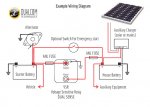TernVI
Well-known member
Or maybe a diode drop from 14.8V would be about right?Connecting the engine battery to a bank of Trojans, being charged at 14.8v from a 500w solar array will make the engine battery very short lived.
Come to that, the bow battery might not be too happy.
Depending on the batteries being used, a B2B might be a better choice for the bow battery and leave the engine off of solar charging.
By coincidence the OP has a diode splitter lying idle.
I'm not really keen on just using diodes to drop voltage, because big diodes often have quite small drops at low currents.
Two small B2B chargers would be a proper solution, if the OP thinks he has enough of problem to want to spend three figures solving it.
Personally I think the long lifetimes of the bow and engine batteries suggest the system has some merits as it is.
An electronics DIYer would consider float charging the Bow and Engine batteries from the small solar panel .
Or build a VSR with some intelligence so the over-voltage situations were avoided.


